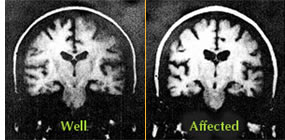| |
For
Families and Friends
A Message for Caregivers
A Message for Teens
Arm Yourself with the Facts
Consequences of Stigma
Myths About Schizophrenia
What Causes Schizophrenia?
How the Brain Operates
The Course and Outcome
Stepping Stones to Recovery
Reintegration
The Stereotype of Violence
Schizophrenia at School,
Work, and in Relationships
Links to Other Resources
|
Myth / Poor parenting causes schizophrenia.
Fact / Psychiatrists since Sigmund Freud
have regarded the family environment as the key factor in the development
of the personality. It seemed clear to many that a disturbed individual
must be the product of a disturbed family. Under Freud’s influence,
researchers and clinicians identified many traits such as "contradictory
expectations" and "covert rejection" which supposedly characterized
families of people with schizophrenia. These studies were almost always
retrospective; they often lacked controls, and they failed to consider
that family tumult might be the result of, rather than the cause of, the
presence of a schizophrenic family member.
As late as the 1970s, textbooks still blamed
"schizophrenogenic" mothers for causing their children’s
illness. Uncounted families have suffered shame, guilt, and stigma as
a consequence of the widespread acceptance of such theorizing. No good
evidence supports the theory that family environment causes schizophrenia,
and very strong evidence supports biological factors as the cause.
Coping with a family member who has schizophrenia
is extremely demanding. Many families break up under the strain or abandon
their ill family member. Families need empathy and support just as those
with schizophrenia do.
Where in the brain / Scientists looking at
the structure of the brain have noticed differences in the activities
of certain parts of the brain in people with schizophrenia. These changes
have been seen in what is called the "limbic region" of the
brain.
The limbic region includes a complex system
of nerve pathways and networks. Structurally these include the amygdala
and hippocampus. This area is responsible for basic human functions such
as drive for reproduction, searching for food, fear, rage, pleasure, and
the establishment of memory patterns.
These structures are visable to the naked
eye-- but for now let’s look at what is going on down at the cellular
level in or among interneurons in the limbic system.
Imagine a radio tuned to several stations at once
/ Research into the operation of the brain has shown that people
with schizophrenia have problems with certain types of brain cells, called
inhibitory interneurons. Inhibitory interneurons damp down the action
of other nerve cells, preventing them from responding to too many inputs.
Thus they prevent the brain from being overwhelmed by too much sensory
information from the environment. Interneurons normally manufacture several
chemicals called neurotransmitters.
The abnormal function of these interneurons
appears to produce changes in the brain cells that release the neurotransmitter
dopamine. A dysfunction of dopaminergic systems has long been considered
important to schizophrenia. In fact, drugs such as amphetamines increase
dopamine’s effects and can cause psychoses that resemble schizophrenia.

Myth / People with schizophrenia are mentally
retarded.
Fact / Schizophrenia and mental retardation
are entirely different conditions. Schizophrenia occurs in people of all
levels of intelligence, and often in talented and creative people. Schizophrenia
does cause some cognitive problems such as poor concentration and difficulty
with abstract thinking. However, it does not affect overall intelligence.
The Tools / For a long time, scientists have
studied the brain’s functioning by examining brain tissue after death.
But technology now allows researchers to look into a brain in operation.
They use a number of different tools:
- CT-Scan is Computerized Tomography and involves passing x-rays through
the body. It provides images of the structures of the brain and was
largely responsible for showing researchers differences in the ventricular
system, particularly in the frontal lobes and left hemisphere.
- MRI stands for Magnetic Resonance Imaging. It produces a three-dimensional
picture of the brain, giving researchers more detailed information than
a C-T scan.
Three other techniques, Functional Magnetic Resonance Imaging, Single
Photon Emission Computed Tomography, and Positron Emission Tomography,
allow scientists to monitor the blood flow into different regions of the
brain.
_______________________

|
